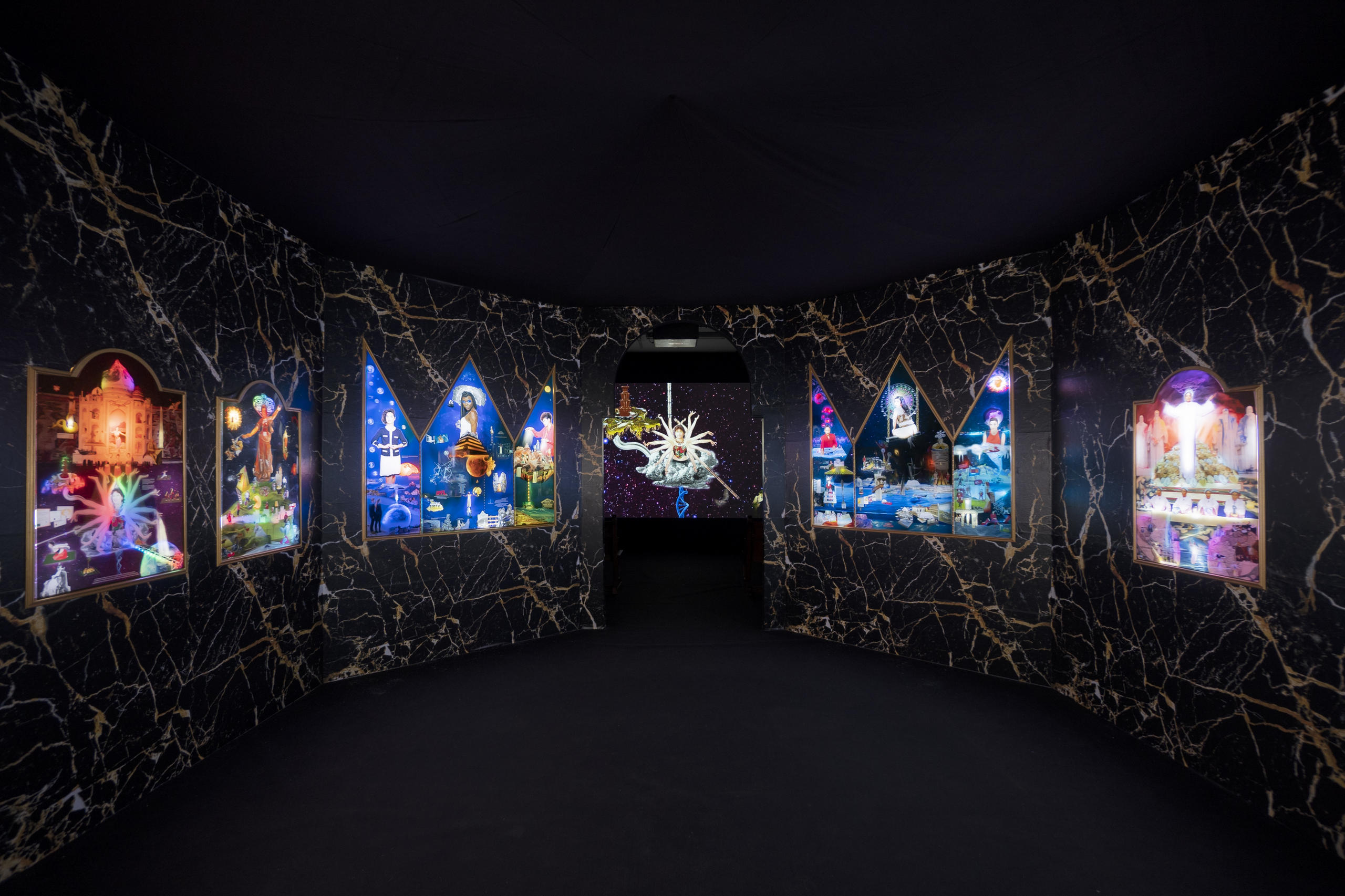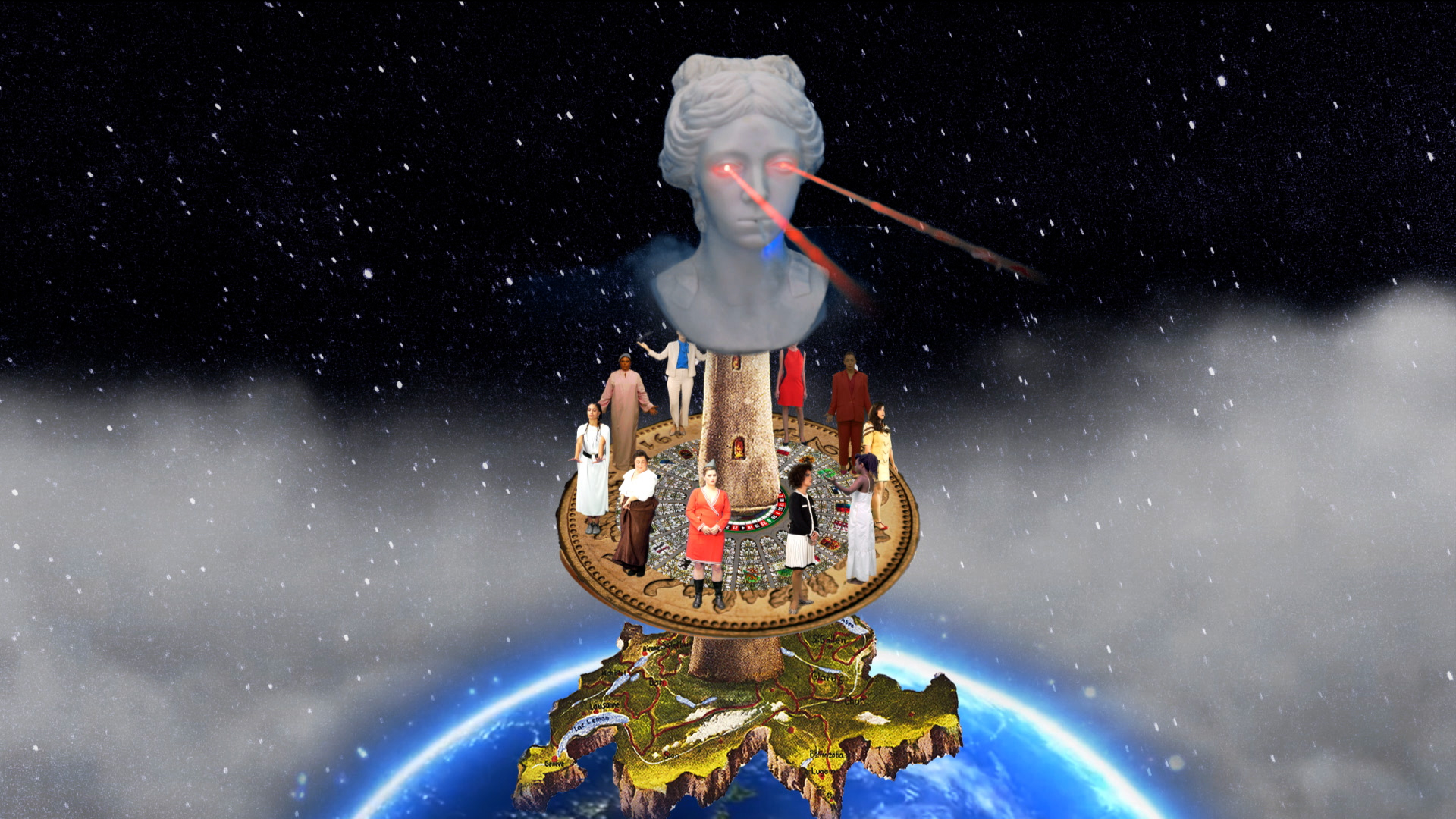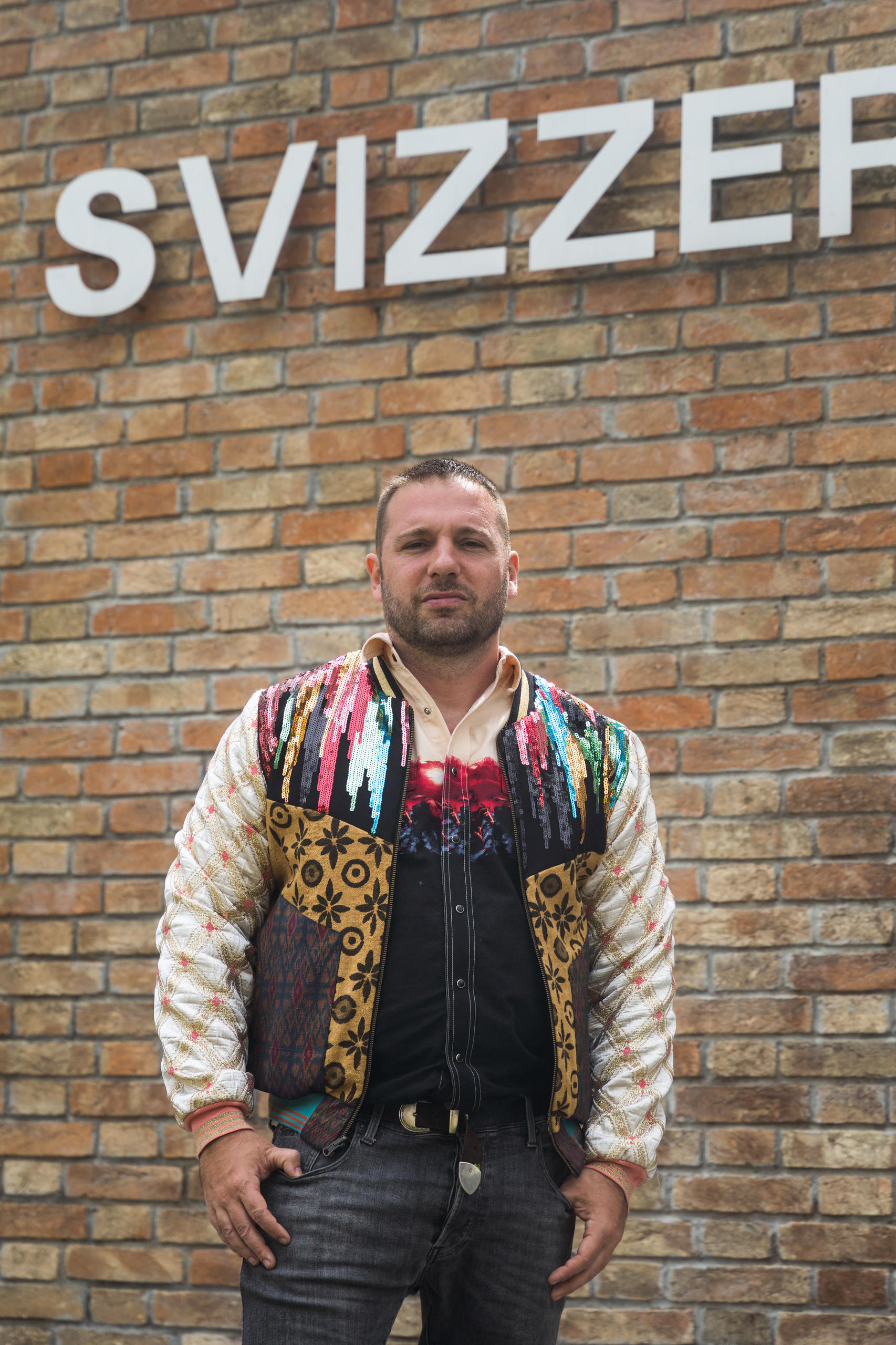
Guerreiro do Divino Amor, a Swiss warrior at the gates of Venice

An architect of parallel worlds, the Swiss-Brazilian artist Guerreiro do Divino Amor (Warrior of Divine Love, in Portuguese) has been chosen to represent Switzerland at the 2024 Venice Biennale of Arts. SWI swissinfo.ch visited his studio to get a glimpse of the artist’s plans for the big event next year.
The theme of the 60th edition of the Venice Biennale, which will run next year from April 20 to November 24, perfectly suits the artist who will occupy the Swiss pavilion, even though the Swiss show is not directly connected to the main exhibition. “Foreigners Everywhere”, the title of the collective exhibition curated by the Brazilian Adriano Pedrosa in the Arsenale, the Biennale’s main venue, reflects Guerreiro do Divino Amor’s condition:. “I speak six languages, none without an accent. Everywhere I go, I’m perceived as a foreigner,” says the artist who is both a Swiss and Brazilian national.
Born in Geneva and raised in Paris, Grenoble, Brussels and Rio de Janeiro, Guerreiro do Divino Amor is known for his audiovisual and graphic installations. In them, all kings, queens and subjects are always naked. The artist creates parallel worlds, linked by bridges of attraction and repulsion, based on both utopian and dystopian images. Guerreiro do Divino Amor thus represents what he calls his “superfictional allegories”, or “institutional science fiction universes”: the artist on a tightrope between the present and the future of all his six fluent languages.
SWI swissinfo.ch interviewed Guerreiro do Divino Amor from his new studio in Rio de Janeiro. Situated on the 29th floor, it overlooks one of the main thoroughfares of the city, Avenida Rio Branco, which pulses with life 24/7.
His studio is still empty apart from a bed, a table, and a chair, as well as a plant, called the sword of St George, known in English as the snake plant or devil’s tongue.
The window overlooks the infinity of buildings and mountains, visual noises that frame the horizon. They stimulate the creativity of this privileged observer. “It was what I was looking for. I found it hard to work and concentrate at home. And now that I have such a large amount of work, this space has become necessary,” he said.
It is from this studio of around 20m2 that Guerreiro do Divino Amor will prepare his commission for Venice – and not in the old, Swiss-looking townhouse in the Rio Comprido neighbourhood, where he has lived for ten years.
After our interview he will be on his way to Rome to shoot a film for the Biennale.

SWI swissinfo.ch: What’s your name on your identity card?
Guerreiro do Divino Amor: Antonie Guerreiro Golay. I’m the son of Rosa Guerreiro, a Brazilian, and Eric Golay, a Swiss. My stage name came about when my father was living another story.
SWI: What story?
GdDA: The name began as a joke in this church where my father was dating an evangelical pastor – at the time she wasn’t even a pastor yet, she was a fervent neo-Pentecostal who went through different churches. She had this mission of attracting new people, believers, and so she asked me to join a [religious] heavy metal band.
At the time, I was a teenager and very much into heavy metal. She was a woman from Nilópolis [in the state of Rio de Janeiro] who lived in Switzerland. It was 1999. And I came up with the name Guerreiro do Divino Amor. In fact, Guerreiro [warrior] was already my surname on my mother’s side. But it was a joke then. And when I started doing art, I always used this name.
SWI: Where do these parallel worlds in your work come from?
GdDA: My process is very gradual. It is made of accumulations. My work began in 2004 with a flood of information, of memories, but also with a search for the surface of things, for institutional references, for what places want to show about themselves.
The videos I make always have these institutional fragments as part of the surface. In the Swiss video we have President Simonetta [Sommaruga]’s speech, in other chapters you find promotional videos for Rio de Janeiro and São Paulo. These images are constructed to attract the tourist, or the investor. And they are all an exercise of imagination over the city.
SWI: And what did you do with this material?
GdDA: First, it became a magazine, The Battle of Brussels, where I imagined a war between these two civilisations, what I call the “superimperium” and the “supergalaxies”. The newspaper The Battle of Brussels was born from this allegory. In the Swiss magazine, The Miracle of Helvetia, I present a superfictional war between Switzerland and Amazonia, the Amazon.
It is a continuation of The Battle of Brussels, with the Amazon being the seat of supergalaxies, which are all other possible models of civilisations, both in the future and in the past. Parallel civilisations that have a different operating logic, so to speak. And Switzerland would be the seat of this super empire, like the apotheosis of capitalism.
SWI: Would the commands of the new order come from Switzerland?
GdDA: Superficially, symbolically, allegorically, Switzerland is like the embodiment of the apotheosis of this model, where everything is…
SWI: Sanitised?
GdDA: Hygienic, yes, but at the same time, everything is perfect, in balance. The superfictional proof that the model can work. Because there’s a balance of nature, culture, technology, “rusticity” and sophistication. So it’s all within an imaginary construction of this perfect world.

SWI: How did you receive this call from the Biennale?
GdDA: When I presented the work at the Centre for Contemporary Art in Geneva, in 2022, it was the first time in Switzerland that I was able to do a retrospective, with [curator] Andrea Bellini. There I developed all these chapters in a specific environment of colour, light and materials, and created an installation for each chapter of the atlas. Thanks to this exhibition, I was invited to compete with five other Swiss artists to create the Swiss pavilion at the Venice Biennale.
The show was so successful that I asked Bellini to work with me on the Venice Pavilion when I was shortlisted to represent Switzerland. Now, with this big Biennale project, I have more time and more resources to develop, even to take it into the third dimension, to create these immersive environments that are an extension of the universe of videos and publications.
SWI: What is this new project like?
GdDA: This new project talks a lot about the architecture of power, of columns, of Rome… of these architectural symbols, of how they have been used around the world, in different eras, always in this imagery of power and supremacy. These days I’ve been working on the costumes for the film; together with architecture, fashion has also something to say in these representations of power.
The work has something pompous about it; it increases the self-representation of the countries, in that old sense of universal exhibitions, of geopolitical games of cultural power. So it’s as if the Biennale itself and its Giardini (gardens) were already part of the work itself, because the work in the Swiss Pavilion connects with others.
SWI: Does your work intend to create a catharsis for the target society, i.e. the people who live in the places that you work on your superfictions?
GdDA: Everything is already present in the discourse itself. For example, in the case of condominiumsExternal link, I once took my mum with me to a real estate development project as if I was going to buy a flat. The place was called “Ilha Pura”, pure island. The name says it all, it was the condominium that would become the Olympic Village – the real one, built for the Rio Olympics of 2016. The salesmen’s discourse was extremely racist and segregating, uttered with the utmost naturality because they were theoretically among people of the same class.
Placing these images and discourses of an artificial perfection to be sold in a collage makes the emptiness and fragility of these representations resonate. It makes ordinary things absurd, grotesque. And I like it when the work is exhibited in the place where it was made, because the public connects directly with all the references. I like it when people yell when they watch, even more so in the arts, where everything is so quiet.

SWI: Did you also see this kind of reaction at the show in Geneva?
GdDA: People there are usually more restrained, but they shouted and laughed and clapped. People got really excited; it touched something deep within them. I was very moved. During this Swiss exhibition, the educational team also set workshops with teenagers to imagine their own superfictions.
I’m very happy when the work is used in the classroom, whether it’s in sociology, art or history. As my artworks are allegorical elements of popular culture, like icons, historical or mediatic, which carry so many meanings within themselves, schoolchildren recognise them straight away. In this sense, I take a lot of inspiration and references from the Brazilian Carnival.
SWI: Can we say that your work is a social, political and economic cartography?
GdDA: It is a work of cartography, yes. My first academic paper, in 2002, in architecture, was about cartography as an instrument of power. It was a work of historical analysis. And that’s where this idea of cartography in my work began, the project was called the World Super-Encyclopedia, chapters of an Atlas.
SWI: And the Biennale is now part of your personal atlas, right?
GdDA: It’s going to be a new chapter. We’re creating this new great allegory of Switzerland and Rome, using a different technique. There may even be paintings. But it’s a surprise. I can’t talk about it.

SWI: Can you separate Guerreiro, the Warrior, from Antoine?
GdDA: No, I’m both all the time. People call me both. My work has really helped to glue all these pieces of myself together: growing up in different contexts, speaking Portuguese at home, studying in France. Besides, my father didn’t identify much with Switzerland.
SWI: And in your life as an immigrant, was it easier to integrate here or there?
GdDA: I speak six languages, none without an accent. Everywhere I go I’m perceived as a foreigner. Even here, where I feel at home. For a long time, I tried very hard to fit in where I was. I’ve always lived between diverse cultures and contradictory social contexts.
There are several parallel civilisations in Brazil. I think my work comes partly from this ability to try to integrate and never succeed. But in these attempts we come to understand a lot of things. A lot of observation, trying to mimesis ourselves, repeating words like a parrot, incorporating some of them. But today I no longer worry about fitting in.
> For a better idea of the artist’s aesthetics, take a look at this video, Cristalização de Brasília (Cristalisation of Brasilia), done in the Brazilian capital in 2019 (in Portuguese):
Edited by Eduardo Simantob and Virginie Mangin/ts
Eduardo Simantob

In compliance with the JTI standards
More: SWI swissinfo.ch certified by the Journalism Trust Initiative































You can find an overview of ongoing debates with our journalists here . Please join us!
If you want to start a conversation about a topic raised in this article or want to report factual errors, email us at english@swissinfo.ch.